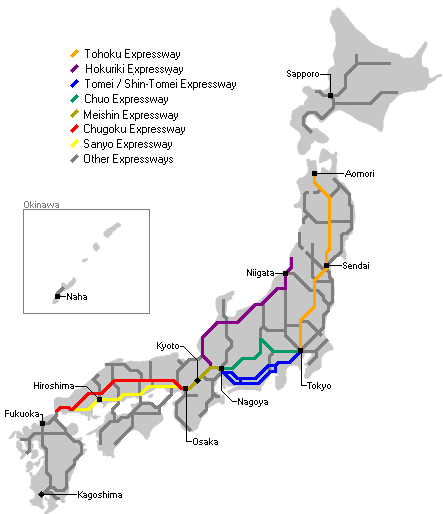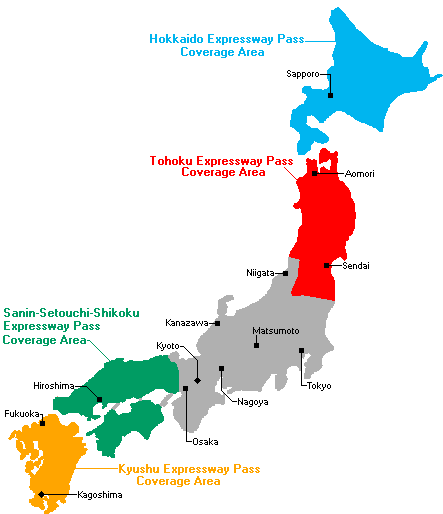Expressways

Japan's four main island and Okinawa are covered by an expressway (高速道路, kōsokudōro) network of over 10,000 kilometers. Further routes are still under construction. Below is a map showing the major operational expressways.

Foreign visitors should encounter few problems using Japanese expressways, since all important signs are written in both Japanese and English. The speed limit for passenger cars is usually 80 or 100 km/h, except on one-lane expressways where the speed limit is 70 km/h.
Below is some vocabulary useful for using Japanese expressways:
- Interchange (IC)
In Japan, an interchange refers to an expressway entrance and exit, e.g. Tokyo IC. - Junction (JCT)
Like in English, a junction refers to a place where multiple expressways meet. - Parking Area (PA)
A parking area comes with toilets and one or more vending machines. Sometimes it also features a restaurant. - Service Area (SA)
Generally larger than parking areas, service areas feature toilets, shops, restaurants and a gasoline stand.
The use of most expressways is subject to tolls, which can be paid at manual toll gates by cash or credit card or by passing through automatic ETC (electronic toll collection) gates. The use of ETC gates requires an ETC card and a car that is equipped with an ETC card reader. ETC cards require ownership of a Japanese credit card and provide discounts during certain times of the day and week. Short term visitors to Japan can acquire ETC cards temporarily from some rental car outlets.
The table below shows approximate costs for regular vehicles between major cities. Lower rates apply to light vehicles and motorcycles, while higher rates apply to trucks and buses.
Approximate tolls (in yen)
|
|
|
|
|
|
|
| |
| Tokyo |
|
|
|
|
|
|
|
| Aomori |
|
|
|
|
|
| |
| Nagoya |
|
|
|
|
| ||
| Kyoto |
|
|
|
| |||
| Osaka |
|
|
| ||||
| Hiroshima |
|
| |||||
| Fukuoka |
|
Approximate Travel Distance
|
|
|
|
|
|
|
|
|
| Tokyo |
|
|
|
|
|
|
|
| Aomori |
|
|
|
|
|
| |
| Nagoya |
|
|
|
|
| ||
| Kyoto |
|
|
|
| |||
| Osaka |
|
|
| ||||
| Hiroshima |
|
| |||||
| Fukuoka |
|
Six companies are in charge of expressway construction and maintenance:
- East Nippon Expressway (Hokkaido, Tohoku, Kanto)
- Central Nippon Expressway (Kanto, Chubu)
- West Nippon Expressway (Kansai, Chugoku, Shikoku, Kyushu)
- Metropolitan Expressway (metropolitan Tokyo)
- Hanshin Expressway (Osaka and Kobe)
- Honshu-Shikoku Bridge Expressway (three bridge connections between Shikoku and Honshu)
Expressway passes
There are a few passes available to foreign visitors that grant unlimited use of designated expressways within a particular coverage area and for a set number of days. The passes are acquired along with rental cars at designated car rental outlets within the pass' coverage area. The passes work through ETC cards provided to drivers, allowing for easy travel around the expressway network.
The expressway passes can be good value for those who plan to travel long distances by car within a certain area over a relatively short time period. They are seldom good value for those merely driving from one city to another. The available expressway passes are as follows:
- Hokkaido Expressway Pass
Price: from 7,700 yen (4 days) to 15,400 yen (8 days)
Coverage Area: Hokkaido - Tohoku Expressway Pass
Price: from 8,500 yen (4 days) to 17,000 yen (8 days)
Coverage Area: Tohoku Region - Sanin-Setouchi-Shikoku Expressway Pass
Price: from 10,700 yen (3 days) to 17,700 yen (10 days)
Coverage Area: Western Honshu and Shikoku, except the bridges between Honshu and Shikoku - Kyushu Expressway Pass
Price: from 6,200 yen (2 days) to 23,800 yen (10 days)
Coverage Area: Kyushu

Questions? Ask in our forum.


